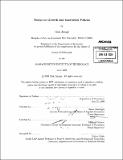Essays on growth and innovation policies
Author(s)
Akcigit, Ufuk
DownloadFull printable version (9.626Mb)
Other Contributors
Massachusetts Institute of Technology. Dept. of Economics.
Advisor
Daron Acemoglu and Mikhail Golosov.
Terms of use
Metadata
Show full item recordAbstract
This thesis consists of three chapters on innovation and economic growth. Chapter 1 is a joint work with Daron Acemoglu. We study the form of intellectual property rights (IPR) policy and licensing in the context of endogenous economic growth with step-by-step cumulative innovation. The main questions of the analysis are as follows. Should a company with a large technological lead receive the same IPR protection as a company with a more limited advantage? Should technological followers be able to license the products of technological leaders? We propose a general equilibrium framework to investigate these questions. IPR policy regulates whether followers in an industry can copy the technology of the leader and also how much they have to pay to license past innovations. We prove the existence of a steady-state equilibrium and characterize some of its properties. We then quantitatively investigate the implications of different types of IPR policy on the equilibrium growth rate and welfare. The two major results of this exercise are as follows. First, the growth rate and welfare in the standard models used in the (growth) literature can be improved significantly by introducing a simple form of licensing. Second and more importantly, full patent protection is not optimal from the viewpoint of maximizing welfare; instead, welfare-maximizing (and growth-maximizing) policy involves state-dependent IPR protection, providing greater protection to technological leaders that are further ahead than those that are close to their followers. (cont.) This form of the welfare-maximizing policy is a result of the "trickle-down"effect, which implies that providing greater protection to firms that are further ahead of their followers than a certain threshold increases the R&D incentives also for all technological leaders that are less advanced than this threshold. Chapter 2 is an empirical study that analyses the relationship between firm size and innovation. The common practice in the endogenous growth literature is to assume a constant innovation quality (size) and focus only on innovation frequency. In this chapter, I test the validity of this assumption using Compustat and USPTO patent data to examine the relationship between firm size and innovation quality. Since R&D investment is the input and firm growth is the result of innovation, this chapter studies the relationship between firm size - firm growth and firm size - R&D intensity as well. The reduced form results uncover three stylized facts: Smaller firm grow faster, are more R&D intensive and more interestingly, produce higher quality innovations. These results are robust, among many other things, to sample selection and to differences in patenting behaviors. In Chapter 3, I propose a theoretical model to understand the microfoundations underlying these stylized facts. In this model, technologically heterogenous firms compete for innovation. A novelty of this model is that firms can endogenously choose not only the probability of innovation, but also the innovation quality. (cont.) I prove the existence of the equilibrium and show that the model's predictions are consistent with the aforementioned reduced form evidences. These results rely on two assumptions: the concavity of the profit function with respect to firm size and the constant returns to scale property of the R&D production function. The intuition is that, when profits are concave, the incentives for radical innovation diminishes as firm size increases. As a result, R&D intensity and firm growth also decrease. Next, I estimate the structural parameters of the model using Simulated Methods of Moments and use the results to conduct a policy experiment. Since firms in this model do not internalize the positive externalities that they generate on other firms, there is underinvestment in R&D, so that there is scope for policy action through size-dependent R&D subsidies. In conclusion of this policy experiment, the optimal size-dependent R&D subsidy policy does considerably better than optimal uniform (size-independent) policy. Moreover, supporting small firms is more growth-enhancing than subsidizing big firms. For a large range of values for the elasticity of substitution, the growth enhancing effect dominates the negative impact of public spending on initial consumption. Therefore, the optimal (welfare-maximizing) policy provides higher subsidies to smaller firms.
Description
Thesis (Ph. D.)--Massachusetts Institute of Technology, Dept. of Economics, 2009. Includes bibliographical references.
Date issued
2009Department
Massachusetts Institute of Technology. Department of EconomicsPublisher
Massachusetts Institute of Technology
Keywords
Economics.